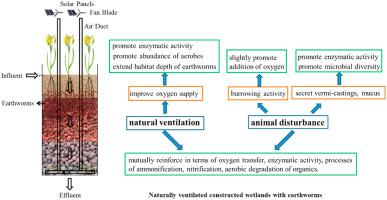Chemosphere ( IF 8.1 ) Pub Date : 2021-06-14 , DOI: 10.1016/j.chemosphere.2021.131175 Xiaoou Wang 1 , Jun Bai 1 , Yimei Tian 2 , Tao Wang 1 , Xiaoxuan Zhou 1 , Changping Zhang 1

|
This study investigated the feasibility of combining natural ventilation and animal disturbance in constructed wetlands (CWs) and the joint effects on oxygen transfer, microbial activity, organics, and nitrogen removal. The results showed that natural ventilation extended the habitat depth of earthworms by approximately 10 cm by significantly improving oxygen transfer in CWs; in turn, the earthworms slightly promoted the addition of oxygen inside CWs through burrowing activity. Therefore, the interaction between natural ventilation and animal disturbance in CWs mutually reinforced oxygen transfer, enzymatic activity, and the ammonification, nitrification, and aerobic degradation of organics. Additionally, the combination of natural ventilation and animal disturbance in CWs promoted the oxygen transfer rate by 42.1%–68.2%; promoted catalase, urease, and dehydrogenase activity by 19.3%–24.8%, 17.4%–22.3%, and 18.1%–25.6%, respectively; and promoted COD and NH3–N removal loads by 48.6%–74.2% and 94.9%–135.3%, respectively. To achieve higher total nitrogen removal, moderate wind speeds (≤1 m/s in this study) are recommended to simultaneously create aerobic and anoxic/anaerobic conditions. Although natural ventilation reduced the microbial diversity in CWs by promoting the abundance of aerobes, the combination of natural ventilation and animal disturbance was generally conducive to improving microbial diversity. The relationship between wind speed and oxygen transfer rate and COD and NH3–N removal loads in naturally ventilated CWs conformed to cubic equations.
中文翻译:

自然通风和动物干扰对人工湿地氧气转移、污染物去除和微生物活动的协同作用
本研究调查了在人工湿地 (CW) 中结合自然通风和动物干扰的可行性,以及对氧气转移、微生物活动、有机物和脱氮的联合影响。结果表明,自然通风通过显着改善 CW 中的氧气传输,将蚯蚓的栖息地深度扩展了约 10 cm;反过来,蚯蚓通过挖洞活动略微促进了 CW 内氧气的添加。因此,CWs 中自然通风和动物干扰之间的相互作用相互加强了氧气的转移、酶的活性以及有机物的氨化、硝化和好氧降解。此外,CW 中自然通风和动物干扰的结合使氧气转移率提高了 42.1%–68.2%;促进过氧化氢酶、脲酶、和脱氢酶活性分别增加 19.3%–24.8%、17.4%–22.3% 和 18.1%–25.6%;并提升 COD 和 NH3 –N 去除载荷分别增加了 48.6%–74.2% 和 94.9%–135.3%。为了实现更高的总氮去除率,建议中等风速(本研究中≤1 m/s)同时创造有氧和缺氧/厌氧条件。虽然自然通风通过促进需氧菌的丰度降低了CWs中的微生物多样性,但自然通风和动物干扰的结合通常有利于提高微生物多样性。自然通风CWs中风速和氧气转移率与COD和NH 3 -N去除负荷之间的关系符合三次方程。











































 京公网安备 11010802027423号
京公网安备 11010802027423号